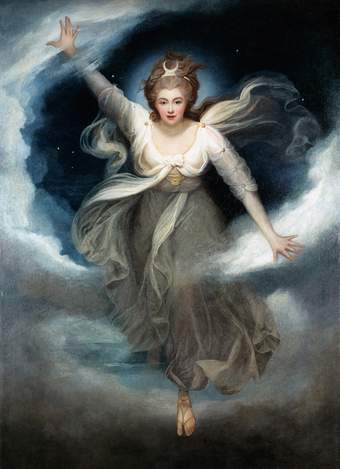
Maria Cosway, Georgiana as Cynthia from Spenser's 'Faerie Queene', 1781-82. Reproduced by permission of Chatsworth Settlement Trustees / Bridgeman Images
Tate Britain presents Now You See Us: Women Artists in Britain 1520-1920. This ambitious group show charts women’s road to being recognised as professional artists, a 400-year journey which paved the way for future generations and established what it meant to be a woman in the British art world. The exhibition covers the period in which women were visibly working as professional artists, but went against societal expectations to do so.
Featuring over 100 artists, the exhibition celebrates well-known names such as Artemisia Gentileschi, Angelica Kauffman, Julia Margaret Cameron and Gwen John, alongside many others who are only now being rediscovered. Their careers were as varied as the works they produced: some prevailed over genres deemed suitable for women like watercolour landscapes and domestic scenes. Others dared to take on subjects dominated by men like battle scenes and the nude, or campaigned for equal access to training and membership of professional institutions. Tate Britain’s exhibition showcases over 200 works, including oil painting, watercolour, pastel, sculpture, photography and ‘needlepainting’ to tell the story of these trailblazing artists.
Now You See Us begins at the Tudor court with Levina Teerlinc, many of whose miniatures will be brought together for the first time in four decades, and Esther Inglis, whose manuscripts contain Britain’s earliest known self-portraits by a woman artist. Focus will be given to the 17th century and one of art history’s most celebrated women artists, Artemisia Gentileschi, who created major works in London at the court of Charles I, including the recently rediscovered Susanna and the Elders 1638-40, on loan from the Royal Collection for the very first time. The exhibition also looks to women such as Mary Beale, Joan Carlile and Maria Verelst who broke new ground as professional portrait painters in oil.
In the 18th century, women artists took part in Britain’s first public art exhibitions, including overlooked figures such as Katherine Read and Mary Black, the sculptor Anne Seymour Damer, and Margaret Sarah Carpenter, a leading figure in her day but little heard of now. The show looks at Angelica Kauffman and Mary Moser, the only women included among the Founder Members of the Royal Academy of Arts; it took 160 years for membership to be granted to another woman. Women artists of this era are often dismissed as amateurs pursuing ‘feminine’ occupations like watercolour and flower painting, but many worked in these genres professionally: needlewoman Mary Linwood, whose gallery was a major tourist attraction; miniaturist Sarah Biffin, who painted with her mouth, having been born without arms; and Augusta Withers, a botanical illustrator employed by the Horticultural Society.
The Victorian period saw a vast expansion in public exhibition venues. Now You See Us showcases major works by critically appraised artists of this period, including Elizabeth Butler (née Thompson)’s monumental The Roll Call 1874 (Butler’s work prompted critic John Ruskin to retract his statement that ‘no women could paint’), and nudes by Henrietta Rae and Annie Swynnerton, which sparked both debate and celebration. The exhibition also looks at women’s connection to activism, including Florence Claxton’s satirical ‘Woman’s Work’: A Medley 1861 which is on public display for the first time since it was painted; and an exploration of the life of Barbara Leigh Smith Bodichon, an early member of the Society of Female Artists who is credited with the campaign for women to be admitted to the Royal Academy Schools. On show is the work of students finally admitted to art schools, as well as their petitions for equal access to life drawing classes.
The exhibition ends in the early 20th century with women’s suffrage and the First World War. Women artists like Gwen John, Vanessa Bell and Helen Saunders played an important role in the emergence of modernism, abstraction and vorticism, but others, such as Anna Airy, who also worked as a war artist, continued to excel in conventional traditions. The final artists in the show, Laura Knight and Ethel Walker, offer powerful examples of ambitious, independent, confident professionals who achieved critical acclaim and – finally – membership of the Royal Academy.
